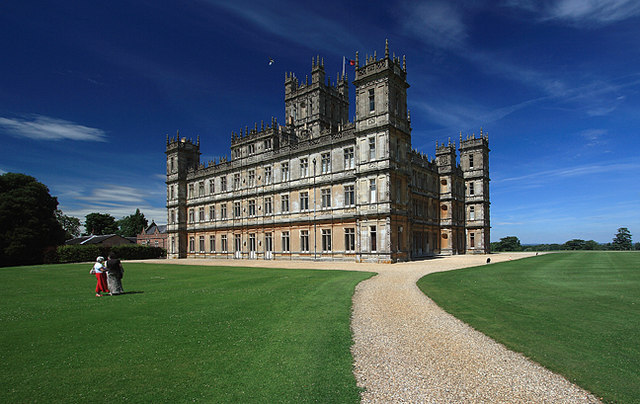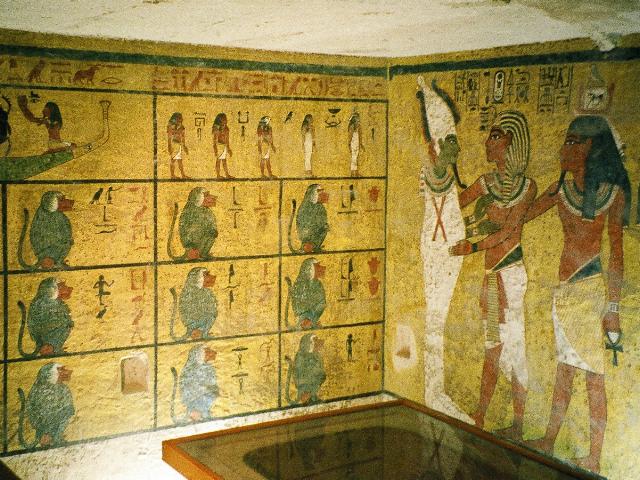|
Henry Herbert, 6th Earl Of Carnarvon
Henry George Alfred Marius Victor Francis Herbert, 6th Earl of Carnarvon (7 November 1898 – 22 September 1987), was a British peer. He was the son of George, 5th Earl of Carnarvon, and Almina Wombwell. Life Styled Lord Porchester from birth, he described in his memoirs an unloving upbringing by his parents, spending much of his time with his grandmother Marie "Mina" Wombwell (). He was educated at Ludgrove School, Eton and Sandhurst. During the First World War he served with the 7th Queen's Own Hussars in India and Mesopotamia, remaining in the army after the war. He inherited the Earldom of Carnarvon in April 1923 on the death of his father – who had funded archaeologist Howard Carter's search for the tomb of Tutankhamun. The new earl's view of the suggested 'Curse of Tutankhamun' was that "however sceptical I might have been, I could not dismiss the matter out of hand", claiming that the moment his father died on 5 April in Egypt, the family dog howled and died ... [...More Info...] [...Related Items...] OR: [Wikipedia] [Google] [Baidu] |
The Right Honourable
''The Right Honourable'' ( abbreviation: ''Rt Hon.'' or variations) is an honorific style traditionally applied to certain persons and collective bodies in the United Kingdom, the former British Empire and the Commonwealth of Nations. The term is predominantly used today as a style associated with the holding of certain senior public offices in the United Kingdom, Canada, New Zealand, and to a lesser extent, Australia. ''Right'' in this context is an adverb meaning 'very' or 'fully'. Grammatically, ''The Right Honourable'' is an adjectival phrase which gives information about a person. As such, it is not considered correct to apply it in direct address, nor to use it on its own as a title in place of a name; but rather it is used in the third person along with a name or noun to be modified. ''Right'' may be abbreviated to ''Rt'', and ''Honourable'' to ''Hon.'', or both. ''The'' is sometimes dropped in written abbreviated form, but is always pronounced. Countries with common or ... [...More Info...] [...Related Items...] OR: [Wikipedia] [Google] [Baidu] |
Eton College
Eton College () is a public school in Eton, Berkshire, England. It was founded in 1440 by Henry VI under the name ''Kynge's College of Our Ladye of Eton besyde Windesore'',Nevill, p. 3 ff. intended as a sister institution to King's College, Cambridge, making it the 18th-oldest Headmasters' and Headmistresses' Conference (HMC) school. Eton is particularly well-known for its history, wealth, and notable alumni, called Old Etonians. Eton is one of only three public schools, along with Harrow (1572) and Radley (1847), to have retained the boys-only, boarding-only tradition, which means that its boys live at the school seven days a week. The remainder (such as Rugby in 1976, Charterhouse in 1971, Westminster in 1973, and Shrewsbury in 2015) have since become co-educational or, in the case of Winchester, as of 2021 are undergoing the transition to that status. Eton has educated prime ministers, world leaders, Nobel laureates, Academy Award and BAFTA award-winning actors, and ge ... [...More Info...] [...Related Items...] OR: [Wikipedia] [Google] [Baidu] |
Polo
Polo is a ball game played on horseback, a traditional field sport and one of the world's oldest known team sports. The game is played by two opposing teams with the objective of scoring using a long-handled wooden mallet to hit a small hard ball through the opposing team's goal. Each team has four mounted riders, and the game usually lasts one to two hours, divided into periods called ''chukkas'' or "''chukkers''". Polo has been called "the sport of kings", and has become a spectator sport for equestrians and high society, often supported by sponsorship. The progenitor of the game and its variants existed from the to the as equestrian games played by nomadic Iranian and Turkic peoples. In Persia, where the sport evolved and developed, it was at first a training game for cavalry units, usually the royal guard or other elite troops. A notable example is Saladin, who was known for being a skilled polo player which contributed to his cavalry training. It is now popular around ... [...More Info...] [...Related Items...] OR: [Wikipedia] [Google] [Baidu] |
Driven Grouse Shooting
Driven grouse shooting is the hunting of the red grouse, a field sport of the United Kingdom. The grouse-shooting season extends from 12 August, often called the " Glorious Twelfth", to 10 December each year. Large numbers of grouse are driven to fly over people with shotguns. Driven grouse shooting first appeared around 1850 and became popular in the later Victorian era as a fashionable sport for the wealthy. The expanding rail network allowed relatively easy access into the remote upland areas of Britain for the first time and driven grouse shooting developed in tandem with this by providing shooting in a convenient and reliable form. Large numbers of birds are driven over a fixed position providing a regular supply of fast moving targets without the need to seek out the birds. The development of the breech-loading shotgun was also an essential ingredient in the development of the practice as it allowed more rapid reloading in the field matching the availability of target birds. ... [...More Info...] [...Related Items...] OR: [Wikipedia] [Google] [Baidu] |
Fox Hunting
Fox hunting is an activity involving the tracking, chase and, if caught, the killing of a fox, traditionally a red fox, by trained foxhounds or other scent hounds. A group of unarmed followers, led by a "master of foxhounds" (or "master of hounds"), follow the hounds on foot or on horseback. In Australia, the term also refers to the hunting of foxes with firearms, similar to deer hunting. Fox hunting with hounds, as a formalised activity, originated in England in the sixteenth century, in a form very similar to that practised until February 2005, when a law banning the activity in England and Wales came into force. A ban on hunting in Scotland had been passed in 2002, but it continues to be within the law in Northern Ireland and several other areas, including Australia, Canada, France, the Republic of Ireland and the United States. The sport is controversial, particularly in the United Kingdom. Proponents of fox hunting view it as an important part of rural culture, and use ... [...More Info...] [...Related Items...] OR: [Wikipedia] [Google] [Baidu] |
Highclere Castle
Highclere Castle is a Grade I listed country house built in 1679 and largely renovated in the 1840s, with a park designed by Capability Brown in the 18th century. The estate is in Highclere in Hampshire, England, about south of Newbury, Berkshire, and north of Andover, Hampshire. It is the country seat of the Earls of Carnarvon, a branch of the Anglo-Welsh Herbert family. Highclere Castle has been used as a filming location for several films and television series, including 1990s comedy series ''Jeeves and Wooster'', and achieved international fame as the main location for the ITV historical drama series ''Downton Abbey'' (2010–15) and the Downton Abbey (film), 2019 and Downton Abbey: A New Era, 2022 films based on it. The house, Egyptian exhibition, and gardens are open to the public for self-guided tours during the summer months and at other times during the rest of the year, such as Christmas and Easter. The house also holds ticketed events, such as the Battle Pr ... [...More Info...] [...Related Items...] OR: [Wikipedia] [Google] [Baidu] |
Howling
Howling is a vocal form of animal communication seen in most canines, particularly wolves, coyotes, foxes, and dogs, as well as cats and some species of monkeys. Howls are generally lengthy sustained sounds, loud and audible over long distances, often with some variation in pitch over the length of the sound. Howling is generally used by animals that engage in this behavior to signal their positions to one another, to call the pack to assemble, or to note their territory. The behavior is occasionally copied by humans, and has been noted to have varying degrees of significance in human culture. In canines The long-distance howling of wolves and coyotes is one way in which canines communicate. Long-distance contact calls are common in Canidae, typically in the form of either barks (termed "pulse trains") or howls (termed "long acoustic streams"). Wolves howl to assemble the pack usually before and after hunts, to pass on an alarm particularly at a den site, to locate each o ... [...More Info...] [...Related Items...] OR: [Wikipedia] [Google] [Baidu] |
Curse Of The Pharaohs
The curse of the pharaohs or the mummy's curse is a curse alleged to be cast upon anyone who disturbs the mummy of an ancient Egyptian, especially a pharaoh. This curse, which does not differentiate between thieves and archaeologists, is claimed to cause bad luck, illness, or death. Since the mid-20th century, many authors and documentaries have argued that the curse is 'real' in the sense of having scientifically explicable causes such as bacteria or radiation. However, the modern origins of Egyptian mummy curse tales, their development primarily in European cultures, the shift from magic to science to explain curses, and their changing uses—from condemning disturbance of the dead to entertaining horror film audiences—suggest that Egyptian curses are primarily a cultural, not scientific, phenomenon. There are occasional instances of genuine ancient curses appearing inside or on the façade of a tomb, as in the case of the mastaba of Khentika Ikhekhi of the 6th Dynasty at Sa ... [...More Info...] [...Related Items...] OR: [Wikipedia] [Google] [Baidu] |
KV62
The tomb of Tutankhamun, also known by its tomb number, KV62, is the burial place of Tutankhamun (reigned c. 1334–1325 BC), a pharaoh of the Eighteenth Dynasty of ancient Egypt, in the Valley of the Kings. The tomb consists of four chambers and an entrance staircase and corridor. It is smaller and less extensively decorated than other Egyptian royal tombs of its time, and it probably originated as a tomb for a non-royal individual that was adapted for Tutankhamun's use after his premature death. Like other pharaohs, Tutankhamun was buried with a wide variety of funerary objects and personal possessions, such as coffins, furniture, clothing and jewellery, though in the unusually limited space these goods had to be densely packed. Robbers entered the tomb twice in the years immediately following the burial, but Tutankhamun's mummy and most of the burial goods remained intact. The tomb's low position, dug into the floor of the valley, allowed its entrance to be hidden by debris de ... [...More Info...] [...Related Items...] OR: [Wikipedia] [Google] [Baidu] |
Howard Carter
Howard Carter (9 May 18742 March 1939) was a British archaeologist and Egyptologist who discovered the intact tomb of the 18th Dynasty Pharaoh Tutankhamun in November 1922, the best-preserved pharaonic tomb ever found in the Valley of the Kings. Early life Howard Carter was born in Kensington on 9 May 1874, the youngest child (of eleven) of artist and illustrator Samuel John Carter and Martha Joyce Carter (). His father helped train and develop his artistic talents. Carter spent much of his childhood with relatives in the Norfolk market town of Swaffham, the birthplace of both his parents. Receiving only limited formal education at Swaffham, he showed talent as an artist. The nearby mansion of the Amherst family, Didlington Hall, contained a sizable collection of Egyptian antiques, which sparked Carter's interest in that subject. Lady Amherst was impressed by his artistic skills, and in 1891 she prompted the Egypt Exploration Fund (EEF) to send Carter to assist an Amherst ... [...More Info...] [...Related Items...] OR: [Wikipedia] [Google] [Baidu] |
Archaeologist
Archaeology or archeology is the scientific study of human activity through the recovery and analysis of material culture. The archaeological record consists of artifacts, architecture, biofacts or ecofacts, sites, and cultural landscapes. Archaeology can be considered both a social science and a branch of the humanities. It is usually considered an independent academic discipline, but may also be classified as part of anthropology (in North America – the four-field approach), history or geography. Archaeologists study human prehistory and history, from the development of the first stone tools at Lomekwi in East Africa 3.3 million years ago up until recent decades. Archaeology is distinct from palaeontology, which is the study of fossil remains. Archaeology is particularly important for learning about prehistoric societies, for which, by definition, there are no written records. Prehistory includes over 99% of the human past, from the Paleolithic until the adve ... [...More Info...] [...Related Items...] OR: [Wikipedia] [Google] [Baidu] |
Mesopotamian Campaign
The Mesopotamian campaign was a campaign in the Middle Eastern theatre of World War I fought between the Allies represented by the British Empire, troops from Britain, Australia and the vast majority from British India, against the Central Powers, mostly the Ottoman Empire. Background The Ottoman Empire had conquered the region in the early 16th century, but never gained complete control. Regional pockets of Ottoman control through local proxy rulers maintained the Ottomans' reach throughout Mesopotamia (modern Iraq). With the turn of the 19th century came reforms. Work began on a Baghdad Railway in 1888; by 1915 it had only four gaps, and travel time from Istanbul to Baghdad had fallen to 21 days. The Anglo-Persian Oil Company (APOC) had obtained exclusive rights to petroleum deposits throughout the Persian Empire, except in the provinces of Azerbaijan, Ghilan, Mazendaran, Asdrabad, and Khorasan.The Encyclopedia Americana, 1920, v.28, p.403 In 1914, months before the war bega ... [...More Info...] [...Related Items...] OR: [Wikipedia] [Google] [Baidu] |
_(cropped).jpg)




_1.jpg)


.jpg)
